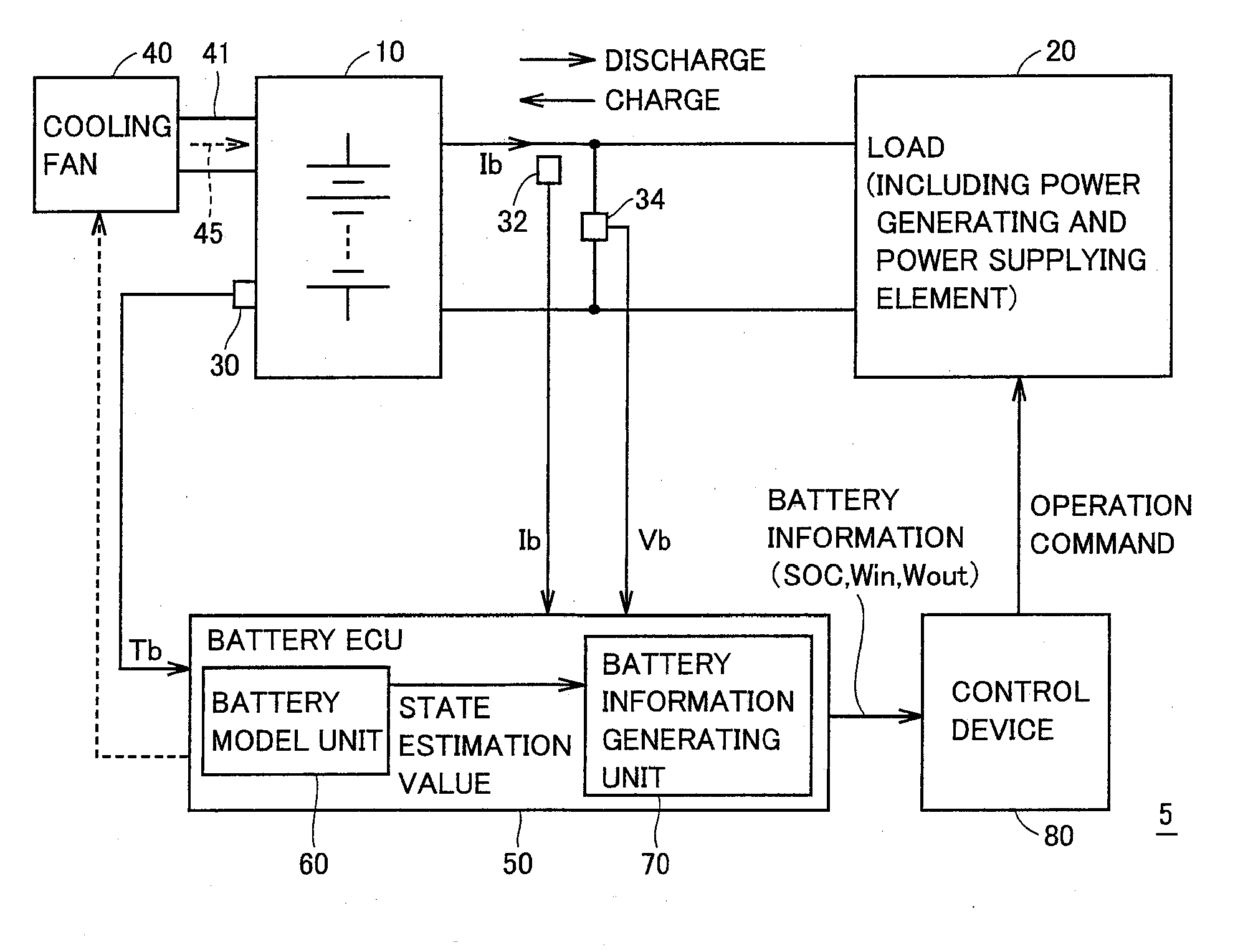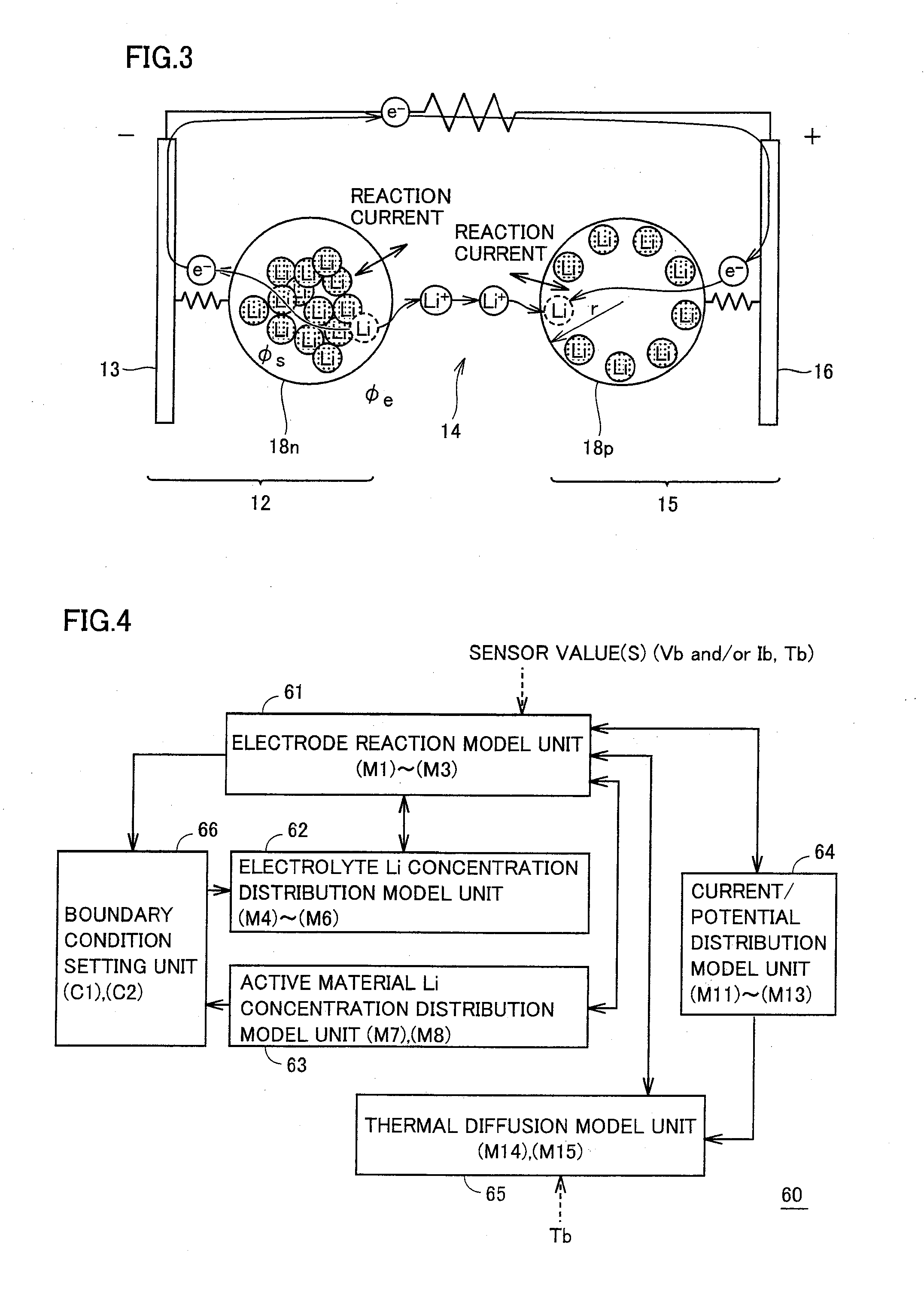Control system of secondary battery and hybrid vehicle equipped with the same
a control system and secondary battery technology, applied in the direction of propulsion parts, electric devices, propulsion using engine-driven generators, etc., can solve problems such as accuracy problems, and achieve the effect of preventing overcharge and overdischarge and rapid deterioration of secondary batteries
- Summary
- Abstract
- Description
- Claims
- Application Information
AI Technical Summary
Benefits of technology
Problems solved by technology
Method used
Image
Examples
first embodiment
[0073]FIG. 1 is a schematic block diagram illustrating a structure of a power supply system controlled by a control system of a secondary battery according to an embodiment of the invention.
[0074]Referring to FIG. 1, a power supply system 5 includes a secondary battery 10, a load 20 and a cooling fan 40 of the secondary battery as well as a battery ECU (Electronic Control Unit) 50 and a control device 80 which are formed of ECUs. Each ECU is typically formed of a microcomputer for executing predetermined sequences and predetermined arithmetic operations that are programmed in advance as well as a memory such as a RAM (Random Access Memory), a ROM (Read Only Memory) or the like. Battery ECU 50 and control device 80 implements a “control system” that executes charge / discharge restrictions to be described below.
[0075]Chargeable and dischargeable secondary battery 10 is typically formed of a lithium ion battery. The lithium ion battery has output characteristics that vary depending on a...
second embodiment
[0118]In and after the second embodiment, the charge / discharge control based on the state estimation values that are calculated according to the battery model discussed in connection with the first embodiment is successively exemplified. First, the second embodiment is discussed in connection with the charge / discharge control reflecting the distribution in secondary battery 10 of the state estimation value that is calculated by battery model unit 60.
[0119](Charge / discharge Control According to Internal Distribution of Lithium Concentration)
[0120]FIGS. 8 to 10 illustrate charge / discharge restrictions in view of the internal distribution of the lithium ion concentration that is handled as the internal state of the secondary battery.
[0121]In FIG. 8, the abscissa gives positional spreading inside the secondary battery (e.g., spreading in the x- and y-directions in the battery model coordinates shown in FIG. 2). The ordinate gives the lithium concentration in active material 18. Thus, FI...
third embodiment
Modification of Third Embodiment
[0181]A modification of the third embodiment will be described in connection with the structure that updates the parameters based on the data during the use of secondary battery 10 without executing a particular diagnostic mode.
[0182]FIG. 20 is a block diagram illustrating a functional structure of a battery ECU according to the modification of the third embodiment.
[0183]Referring to FIG. 20, battery ECU 50 according to the modification of the third embodiment includes battery model unit 60, a parameter identification model unit 68#, an overall SOC calculating unit 69 and parameter managing unit 77.
[0184]Parameter identification model unit 68# receives online sensed values (battery temperature Tb, battery current Ib and battery voltage Vb) sensed by sensors 30-34, and operates in parallel with battery model unit 60. More specifically, it uses, as inputs, the online sensed values of secondary battery 10 during actual use, and identifies online the para...
PUM
 Login to View More
Login to View More Abstract
Description
Claims
Application Information
 Login to View More
Login to View More - R&D
- Intellectual Property
- Life Sciences
- Materials
- Tech Scout
- Unparalleled Data Quality
- Higher Quality Content
- 60% Fewer Hallucinations
Browse by: Latest US Patents, China's latest patents, Technical Efficacy Thesaurus, Application Domain, Technology Topic, Popular Technical Reports.
© 2025 PatSnap. All rights reserved.Legal|Privacy policy|Modern Slavery Act Transparency Statement|Sitemap|About US| Contact US: help@patsnap.com



